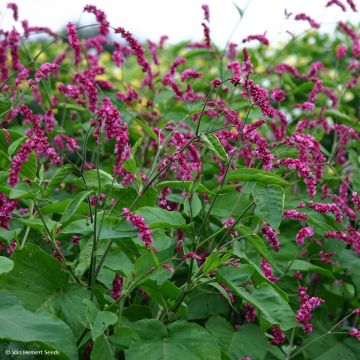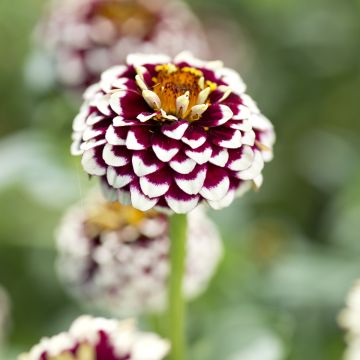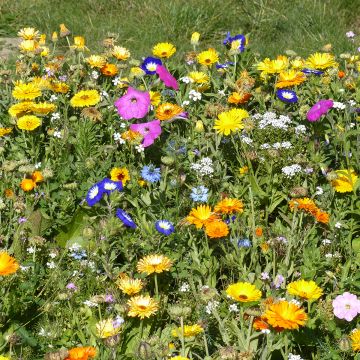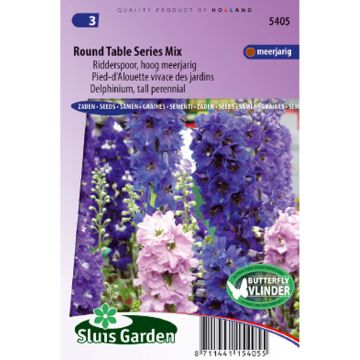

Graines d'Amaranthus paniculatus Autumn Palette - Amarante gigantesque
Amaranthus paniculatus Autumn Palette - Amaranth
Amaranthus paniculatus Autumn Palette
Amaranth
This plant carries a 6 months recovery warranty
More information
We guarantee the quality of our plants for a full growing cycle, and will replace at our expense any plant that fails to recover under normal climatic and planting conditions.
Seed-only orders are dispatched by sealed envelope. The delivery charge for seed-only orders is €3.90.
Delivery to Corse prohibited: UE law prohibits the import of this plant from mainland France to Corse as part of the fight against Xylella fastidiosa. Please accept our sincere apologies.
More information
Does this plant fit my garden?
Set up your Plantfit profile →
Description
This mixture of Amaranthus paniculatus Autumn Palette consists of sumptuous annual plants with rapid growth, displaying large feathery panicles in shades of cream and orange-brown in late summer and autumn. This flowering lasts a long time and does not fade, even when dried. Unique and extravagant, this tall plant showcases the colours of autumn with flair, both in flower beds and in bouquets. Easy to grow in sunny, well-drained, and moist soil.
Native to tropical and subtropical regions of South America, Amaranthus paniculatus is an annual herbaceous plant in the Amaranthaceae family. It is cultivated for ornamental purposes, as well as to a lesser extent for cereal and medicinal use. The Autumn Palette mixture brings together vigorous plants with soft and warm tones in their flowering. This surprising flowering occurs in late summer and autumn. The tiny petal-less flowers, adorned with coloured bracts, are gathered in upright panicle-shaped plumes, carried by plants that reach heights of 90 cm (35in) to 1.20 m (4ft). The flowering plant resembles a bush crowned with faded shades of cream to brown, with hints of orange and biscuit. The plants grow quickly. The thick, reddish, sparsely branched stems bear large, soft leaves, ranging from 3 to 15 cm (1 to 6in) in length, ovate to lanceolate, alternate, with very pronounced veins, in shades ranging from matte green to purple.
Amaranths are theatrical flowers, with a dramatic temperament dispayed in the middle of perennial flower beds and in large pots on patios. They enhance the simple blooms of field daisies, accompany the blue stars of asters or the gleaming suns of echinaceas with fanfare. These plants will make a sensation when planted in groups of 3 to 5 specimens in the midst of a carpet of groundcover plants such as Cerastostima plumbaginoides, Ajuga reptans, or bear's ears.
Report an error about the product description
Flowering
Foliage
Plant habit
Botanical data
Amaranthus
paniculatus
Autumn Palette
Amaranthaceae
Amaranth
Cultivar or hybrid
Other Amaranthus seeds
Planting and care
Sow from March to May. Sow thinly, to a depth of 3mm (0.1in) in small furrows spaced 30 cm (12in) apart, in well-prepared and loosened soil to a depth of 30 cm (12in). Water regularly to maintain some moisture, especially during dry periods. You can also sow in pots or trays filled with moist special sowing compost, covering the seeds with a very fine pinch of compost or vermiculite. Keep the sowing between 20 and 25 ° C. Light promotes germination. Keep the surface of the compost moist but not waterlogged; germination usually takes 3 to 15 days. Transplant the young plants into 7.5 cm (3in) pots or trays. Plant outside once all risk of frost has passed.
Amaranth are heat-loving plants that thrive in nitrogen-rich soil. Plant them in full sun, in light and well-amended soil. Just before frost, you can uproot the plants and burn them to prevent spontaneous seedlings from taking over.
Sowing period
Intended location
This item has not been reviewed yet - be the first to leave a review about it.
Flower seeds
Haven't found what you were looking for?
Hardiness is the lowest winter temperature a plant can endure without suffering serious damage or even dying. However, hardiness is affected by location (a sheltered area, such as a patio), protection (winter cover) and soil type (hardiness is improved by well-drained soil).

Photo Sharing Terms & Conditions
In order to encourage gardeners to interact and share their experiences, Promesse de fleurs offers various media enabling content to be uploaded onto its Site - in particular via the ‘Photo sharing’ module.
The User agrees to refrain from:
- Posting any content that is illegal, prejudicial, insulting, racist, inciteful to hatred, revisionist, contrary to public decency, that infringes on privacy or on the privacy rights of third parties, in particular the publicity rights of persons and goods, intellectual property rights, or the right to privacy.
- Submitting content on behalf of a third party;
- Impersonate the identity of a third party and/or publish any personal information about a third party;
In general, the User undertakes to refrain from any unethical behaviour.
All Content (in particular text, comments, files, images, photos, videos, creative works, etc.), which may be subject to property or intellectual property rights, image or other private rights, shall remain the property of the User, subject to the limited rights granted by the terms of the licence granted by Promesse de fleurs as stated below. Users are at liberty to publish or not to publish such Content on the Site, notably via the ‘Photo Sharing’ facility, and accept that this Content shall be made public and freely accessible, notably on the Internet.
Users further acknowledge, undertake to have ,and guarantee that they hold all necessary rights and permissions to publish such material on the Site, in particular with regard to the legislation in force pertaining to any privacy, property, intellectual property, image, or contractual rights, or rights of any other nature. By publishing such Content on the Site, Users acknowledge accepting full liability as publishers of the Content within the meaning of the law, and grant Promesse de fleurs, free of charge, an inclusive, worldwide licence for the said Content for the entire duration of its publication, including all reproduction, representation, up/downloading, displaying, performing, transmission, and storage rights.
Users also grant permission for their name to be linked to the Content and accept that this link may not always be made available.
By engaging in posting material, Users consent to their Content becoming automatically accessible on the Internet, in particular on other sites and/or blogs and/or web pages of the Promesse de fleurs site, including in particular social pages and the Promesse de fleurs catalogue.
Users may secure the removal of entrusted content free of charge by issuing a simple request via our contact form.
The flowering period indicated on our website applies to countries and regions located in USDA zone 8 (France, the United Kingdom, Ireland, the Netherlands, etc.)
It will vary according to where you live:
- In zones 9 to 10 (Italy, Spain, Greece, etc.), flowering will occur about 2 to 4 weeks earlier.
- In zones 6 to 7 (Germany, Poland, Slovenia, and lower mountainous regions), flowering will be delayed by 2 to 3 weeks.
- In zone 5 (Central Europe, Scandinavia), blooming will be delayed by 3 to 5 weeks.
In temperate climates, pruning of spring-flowering shrubs (forsythia, spireas, etc.) should be done just after flowering.
Pruning of summer-flowering shrubs (Indian Lilac, Perovskia, etc.) can be done in winter or spring.
In cold regions as well as with frost-sensitive plants, avoid pruning too early when severe frosts may still occur.
The planting period indicated on our website applies to countries and regions located in USDA zone 8 (France, United Kingdom, Ireland, Netherlands).
It will vary according to where you live:
- In Mediterranean zones (Marseille, Madrid, Milan, etc.), autumn and winter are the best planting periods.
- In continental zones (Strasbourg, Munich, Vienna, etc.), delay planting by 2 to 3 weeks in spring and bring it forward by 2 to 4 weeks in autumn.
- In mountainous regions (the Alps, Pyrenees, Carpathians, etc.), it is best to plant in late spring (May-June) or late summer (August-September).
The harvesting period indicated on our website applies to countries and regions in USDA zone 8 (France, England, Ireland, the Netherlands).
In colder areas (Scandinavia, Poland, Austria...) fruit and vegetable harvests are likely to be delayed by 3-4 weeks.
In warmer areas (Italy, Spain, Greece, etc.), harvesting will probably take place earlier, depending on weather conditions.
The sowing periods indicated on our website apply to countries and regions within USDA Zone 8 (France, UK, Ireland, Netherlands).
In colder areas (Scandinavia, Poland, Austria...), delay any outdoor sowing by 3-4 weeks, or sow under glass.
In warmer climes (Italy, Spain, Greece, etc.), bring outdoor sowing forward by a few weeks.
























































